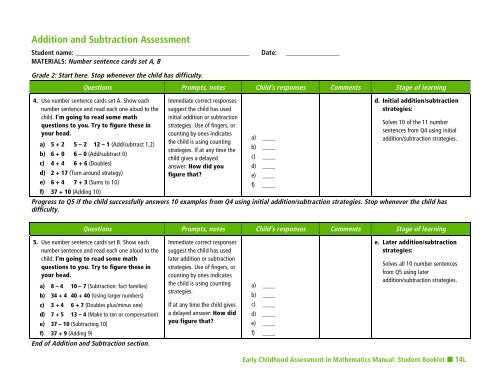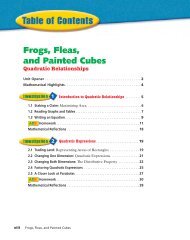ECAM-Manual-and-Resources
ECAM-Manual-and-Resources
ECAM-Manual-and-Resources
Create successful ePaper yourself
Turn your PDF publications into a flip-book with our unique Google optimized e-Paper software.
Addition <strong>and</strong> Subtraction Assessment<br />
Student name: ____________________________________________________ Date: ________________<br />
MATERIALS: Number sentence cards set A, B<br />
Grade 2: Start here. Stop whenever the child has difficulty.<br />
Questions Prompts, notes Child’s responses Comments Stage of learning<br />
4. Use number sentence cards set A. Show each<br />
number sentence <strong>and</strong> read each one aloud to the<br />
child. I’m going to read some math<br />
questions to you. Try to figure these in<br />
your head.<br />
a) 5 + 2 5 – 2 12 – 1 (Add/subtract 1,2)<br />
b) 6 + 0 6 – 0 (Add/subtract 0)<br />
c) 4 + 4 6 + 6 (Doubles)<br />
d) 2 + 17 (Turn around strategy)<br />
e) 6 + 4 7 + 3 (Sums to 10)<br />
f) 37 + 10 (Adding 10)<br />
Immediate correct responses<br />
suggest the child has used<br />
initial addition or subtraction<br />
strategies. Use of fingers, or<br />
counting by ones indicates<br />
the child is using counting<br />
strategies. If at any time the<br />
child gives a delayed<br />
answer: How did you<br />
figure that?<br />
a) ____<br />
b) ____<br />
c) ____<br />
d) ____<br />
e) ____<br />
f) ____<br />
d. Initial addition/subtraction<br />
strategies:<br />
Solves 10 of the 11 number<br />
sentences from Q4 using initial<br />
addition/subtraction strategies.<br />
Progress to Q5 if the child successfully answers 10 examples from Q4 using initial addition/subtraction strategies. Stop whenever the child has<br />
difficulty.<br />
Questions Prompts, notes Child’s responses Comments Stage of learning<br />
5. Use number sentence cards set B. Show each<br />
number sentence <strong>and</strong> read each one aloud to the<br />
child. I’m going to read some math<br />
questions to you. Try to figure these in<br />
your head.<br />
a) 8 – 4 10 – 7 (Subtraction: fact families)<br />
b) 34 + 4 40 + 40 (Using larger numbers)<br />
c) 3 + 4 6 + 7 (Doubles plus/minus one)<br />
d) 7 + 5 13 – 4 (Make to ten or compensation)<br />
e) 37 – 10 (Subtracting 10)<br />
f) 37 + 9 (Adding 9)<br />
Immediate correct responses<br />
suggest the child has used<br />
later addition or subtraction<br />
strategies. Use of fingers, or<br />
counting by ones indicates<br />
the child is using counting<br />
strategies.<br />
If at any time the child gives<br />
a delayed answer: How did<br />
you figure that?<br />
a) ____<br />
b) ____<br />
c) ____<br />
d) ____<br />
e) ____<br />
f) ____<br />
e. Later addition/subtraction<br />
strategies:<br />
Solves all 10 number sentences<br />
from Q5 using later<br />
addition/subtraction strategies.<br />
End of Addition <strong>and</strong> Subtraction section.<br />
Early Childhood Assessment in Mathematics <strong>Manual</strong>: Student Booklet ■ 14L



